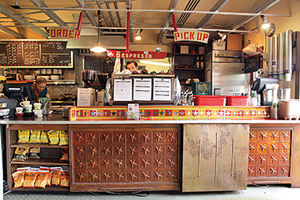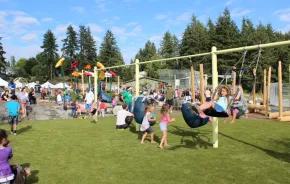
Minutes after launching the aluminum skiff into foggy Nehalem Bay on the Oregon coast, we have a friend: A harbor seal hovers above the water’s surface a few yards away, watching with deep brown eyes as we toss the first trap into the slack-tide water. Tucked inside the crab ring are a fish carcass and a little chicken — bait. “That seal won’t go for the chicken, but crabs sure will,” Joe Zimmerman explains.
Read more Family Adventure Guide stories! Find your summer bucket list, a gold-rush vacation, best summer splurges and more
Zimmerman, from Kelly’s Brighton Marina, is our crabbing guide for the morning. My 8-year old son, Isaac, his star pupil, politely raises his hand and peppers Zimmerman with questions about everything from the species of oysters in Nehalem Bay to gray whale migration patterns off the spit. Our guide happily answers.
The chatter doesn’t keep the seals away, but it might have had an impact on our success with late-winter crabbing. Each hard pull on the rope of a submerged crab ring (“Faster! Faster!”) yields only a handful of juvenile Dungeness crab, far too small for our waiting bucket. Time to move on to another area of the bay.
Crabbing is sort of random. Rookies will sometimes stay in the same place, but Zimmerman tells us you have to test an area and be ready to move on if you’re not getting keepers. We settle into a sheltered cove between two sandbars and drop our three rings about 100 feet apart. When you’re baiting crab with rings, you wait 10 to 15 minutes before checking your traps, whereas a crab pot can sit out all night.
Our bad luck continues, but he explains why. Rainy winters send a torrent of freshwater into these bays, and crab much prefer saltwater, so our season was off. “In summertime, you can walk across the buoys, there are so many of them,” he adds.
Well then, in summertime we shall certainly return.
Hands-on adventures in foraging deepen a child’s understanding of where their food comes from and the importance of preserving these natural resources for generations to come. Plus, digging and trapping for your dinner is fun! Here are three dock-to-table trips to take this summer (and beyond).

Razor clamming on the central Oregon coast
As the gently winding Highway 101 deposits you in Newport, Oregon, check your tide time; you’ll want to be on the beach, scanning the wet sand for “clam shows,” no later than an hour before low tide (the lower the better).
Razor clams — hefty, meaty clams with delicate shells — are typically available just in the cool-season months on Washington’s coastal beaches, but you can find them on Oregon beaches most of the year. Newport, about a five-hour drive from Seattle, is a spectacular destination for your summer razor clamming adventure.
The dunes of Agate Beach sit right between Nye Beach in Newport and the salty cliffs of Yaquina Head, where you’ll find the Oregon Coast’s tallest lighthouse. Grab your buckets, gloves and clam guns (or shovels) and head down to the edge of the surf. The keen eyes of small children are particularly skilled at spotting a razor clam’s characteristic “dimple” (plus, they’re down closer to the ground). Once you’ve spotted one, stab the sand about 5 inches away with the shovel, work it into the sand, pull it away from the dimple, then dig, dig, dig!
Remember to never turn your back on the ocean, and watch out for sneaker waves that can sweep you off your feet. Once you’ve met your catch limit (or are exhausted from digging, whichever comes first) explore the tide pools below the lighthouse at the Yaquina Head Outstanding Natural Area ($7 per vehicle, volunteer naturalists are usually onsite). Keep your razors cold until you get a chance to clean them; they’ll keep in the fridge for a few days.
More to forage: Head to Newport’s historic bay, where one side of the street is a working fish dock (home to Oregon’s largest commercial fishing fleet) and the other is lined with ice cream joints, candy shops and chowder houses. Peruse the catch that fishermen sell right off the boat (we call it “dock foraging”) and sample oysters on the half-shell at Ocean Bleu Seafoods at Gino’s. Want to catch your own? Harry’s Bait & Tackle will rent you a crab pot to hang off the Bay Street Pier.
Don’t miss: Newport’s shining star is the world-class Oregon Coast Aquarium, a living classroom with natural, hands-on exhibits like touch tide pools, sea lions, furry sea otters, playful seabirds and more. At Passages of the Deep, a stunning 200-foot-long acrylic tunnel, five species of sharks and bat rays swim over and under you. Open 10 a.m.–6 p.m. daily; children $15–$20, adults $23, babies and toddlers free.
Stay: Your room with a view at the bluff-top Hallmark Resort (from $159) overlooks the expansive Pacific and all its beautiful sunsets, with the lighthouse to the north and jetty to the south. Watch the fishing fleet come and go and keep an eye on the horizon for passing whales. Amenities include an indoor pool, a sauna and hot tub, and steps that lead straight down to the beach. The adjacent restaurant, Georgie’s Beachside Grill, specializes in fresh, local seafood and has a great kids’ menu.

Crabbing on the northern Oregon coast
The protected saltwater estuaries of Netarts, Tillamook and Nehalem bays are fed with freshwater by snowmelt from mountain streams and washed clean twice daily with Pacific tides. The result? Some of the best seafood foraging in the world, especially crabbing.
Few experiences are more quintessentially Northwest than tossing a crab pot off a dock (or boat) and eating whatever crawls inside. Kelly’s Brighton Marina on Nehalem Bay is an excellent place for a crabbing-by-boat primer ($95). Arrive a few hours before high tide and book the two-hour “crabbing special,” which includes a boat with a motor, three baited crab rings and safety gear. Kelly’s staff start with an engaging dock demo, or they’ll accompany you in the boat (and if you’re lucky, show you their secret crabbing hole). Return to the dock with buckets of Dungeness crab and they’ll boil ’em up for you.
More to forage: Undeveloped Netarts Bay is renowned as a shallow, pristine estuary that transforms into a giant, muddy clam bed at low tide, concealing a feast of littlenecks, gapers, cockles and butter clams. On Tillamook Bay, the fishing village of Garibaldi boasts a reliable cockle bed known as Garibaldi Flat under its main pier, and Garibaldi Marina will rent you crab pots you can drop off the dock.
Stay: Sheltered Nook on Tillamook Bay hosts six custom-built tiny houses in the woods that creatively fit the amenities of a family home into 385 square feet ($110–$175 per night). Cook up your catch in the stocked kitchen or barbecue outdoors while the kids check out the Frisbee golf course. Cottages sleep six; a delicious breakfast basket is included.
Pitch a tent: Cape Lookout State Park sits on both a steep-cliffed promontory and a sand spit that juts out nearly two miles into the Pacific Ocean, sheltering the waters of Netarts Bay. More than 200 campsites and 19 yurts and cabins are available.

Mussels and clams on Whidbey Island
Board a ferry in Mukilteo for the short sail across Possession Sound to the southern tip of laid-back Whidbey Island. With 150 miles of coastline, this long, sinewy island shelters dozens of sandy coves between its rocky bluffs and wind-swept spits. Acres of clams, indeed.
If the tide is high, wander the artsy village of Langley for gallery-hopping and bookstore-browsing. Stop in for a kid-friendly glass-blowing demo at Callahan’s Firehouse (they make the coolest glass fishing floats) then pit stop at Useless Bay Coffee Company next door for chai lattes and sour cream coffee cake.
When approaching low tide, head north to Coupeville, one of Washington’s oldest towns, dating back to 1852 and set along your digging destination: Penn Cove. Clamming is year-round on Whidbey though some beaches experience seasonal closures; West Penn Cove and Twin Lagoon beaches open June 1, 2017, through the end of the year. Those tidelands are hiding your dinner, just waiting to be unearthed: native littleneck clams (higher on the beach), Manila clams, butter clams, cockles (just inches deep and easy to locate with a heavy-tined garden fork) and horse clams (low in the tidal zone).
Not surprisingly, this is an excellent beach for harvesting Penn Cove mussels. Fill in the holes you dig, and mind the per-person limits. Stow your harvest in some seawater to keep them alive until you get to a stove or campfire for your own family clambake.
More to forage: Ala Spit County Park, near Deception Pass, and Long Point, east of Penn Cove, are great for cockles and butter clams. On a day trip? Double Bluff State
Park (aka Useless Bay Tidelands) is just eight miles from the ferry dock and popular for butter clams and native littlenecks.
Stay: The nautical-themed Cozy Harbor Cottage in Coupeville sleeps a family of five and provides a fully equipped kitchen for you to whip up a pot of steamy clam chowder while gazing off your deck at the sunset ($160 per night). For more options on Whidbey, look for vacation home rentals: Many of the island’s lodgings are not kid-friendly.
Pitch a tent: “Clam and camp” at Fort Ebey State Park, where 50 wooded campsites on a bluff are just a short hike from a beach full of clams at minus tide. To the east are beds of oysters, mussels and clams at West Penn Cove beach.

Shellfish safetyBefore you hang the “Gone Clamming” sign on your front door, read these warnings: Keep it legal. Get a recreational shellfish/seaweed harvesting license for each person; they are required for ages 12 and up in Oregon and 15 and up in Washington, and good for one to three days or annually. You can buy licenses at most marinas and general stores in coastal towns. And know the state regulations for dates and catch limits (Washington; Oregon). Mind the tides. Consult a tide chart for where you’re headed to track the optimum times for harvesting shellfish or seaweed. In Oregon, public access to tidelands is guaranteed by law, but access is not guaranteed in Washington. Eat safe shellfish. State wildlife agencies regularly monitor shellfish for biotoxins, pollution and radiation. Check for specific beach closures due to marine biotoxins before you catch and eat; the easiest way to do this is to call the state-funded Shellfish Safety Hotlines (Washington, 800-562-5632; Oregon, 800-448-2474). Get in gear. When it comes to clothes, think warm and dry. Tall rain boots are a must. Rain gear, including waterproof pants and jacket, is nice when crabbing in a skiff and for clam digging in wet sand on your hands and knees. Kids should wear life jackets in boats, in the surf and on docks. |
Three more shellfish adventures
Hood Canal: Get a shrimp pot, load up your bait and lure in the plump and sweet spot shrimp this region is famous for. The season is short, limited to a handful of days in May. Extensive oyster beds at Potlatch State Park are just steps from wooded campsites.
Astoria: Charter a kid-friendly Columbia River fishing guide (Lance Fisher is one of the best) during the summer Chinook run, then fill your freezer with your catch! Kids will love watching fishing and cargo ships from a waterfront room at the Cannery Pier Hotel.
Moclips: Moclips, on Washington’s North Beach, is where to plan your fall razor clamming adventure. Find great clamming near your beach condo at the pet-friendly Hi-Tide Ocean Beach Resort, where they thoughtfully provide a spacious razor-clam cleaning shelter.











